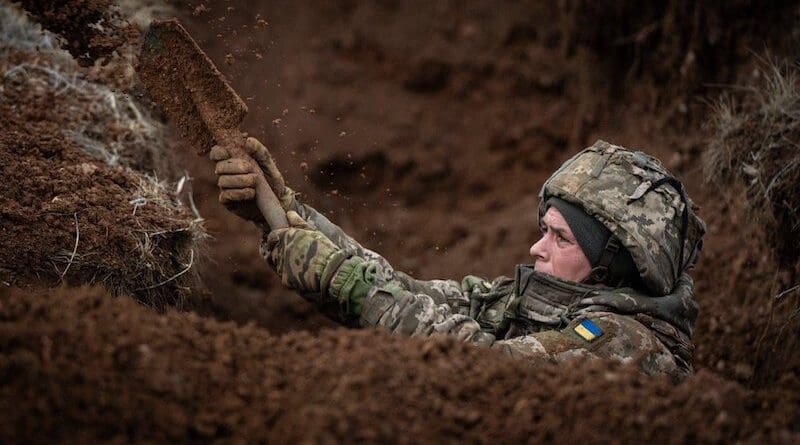Ukraine’s Three-Front War: Advancing Russians, Depleted Artillery, Exhausted Troops – Analysis

A Ukrainian soldier digs a trench. Photo Credit: Ukraine Defense Ministry
By RFE RL
By Mike Eckel
(RFE/RL) — The column of Russian armored vehicles carefully approached Chasiv Yar from the east, threading its way along dirt roads, skirting patches of forest, and avoiding Ukrainian-laid minefields while dodging incoming drones and artillery.
The April 4 assault on the Donetsk region city was repelled, according to Ukrainian commanders, open-source intelligence, and reports from soldiers on the ground. But more troublingly for Ukraine’s beleaguered frontline troops was what the grainy black-and-white drone video released by Ukraine’s 67th Separate Mechanized Brigade showed: a potential weakness in Ukraine’s defense, hastily built in some cases, and smarter tactics by Russian forces than earlier in the invasion.
Chasiv Yar is slowly being wiped from the map as Russian jets drop heavy, guided bombs that flatten apartment blocks and elite airborne assault units edge into the city’s eastern outskirts.
Ukrainian forces are exhausted, starved for artillery shells, desperate for reinforcements and rotations, struggling to hold back Russia’s offensive in several locations across the 1,200-kilometer front line. After the loss of the bigger city of Avdiyivka in February, Chasiv Yar is the next crucible, for Ukraine’s troops and for the West’s will to arm and support them.
“The battle for Chasiv Yar…is a litmus test for both sides,” according to Frontelligence Insight, a Ukrainian open-source research organization run by a Ukrainian reserve officer that analyzed the 64th Brigade drone video. “If Ukraine were to lose control of Chasiv Yar, it could have dire consequences as it would provide a direct route for the Russian Army to advance towards key cities in the Donbas, such as Kostyantynivka and Kramatorsk.”
Chasiv Yar “is one of the hottest spots on the front line,” said Oleksiy Melnyk, a retired Ukrainian Air Force officer and former pilot, as Russia moves closer to the goal of occupying the entirety of the two eastern Ukrainian regions that make up the Donbas: Donetsk and Luhansk.
“That’s why it’s where the most intensive fighting is nowadays, and I assume that in the next weeks, there will be even bigger-scale attempts to capture Chasiv Yar,” Melnyk, now a researcher at the Razumkov Center, a Kyiv think tank, told RFE/RL.
A Faltered Counteroffensive
Last summer, Ukraine pinned its hopes for a decisive shift on the battlefield on a major counteroffensive, armed by Western weaponry and bolstered by nine newly formed, NATO-trained brigades.
The effort faltered by late fall, however. Ukrainian soldiers ran into а buzz saw of extensively prepared Russian defenses: trenches, tank traps, “dragon’s teeth,” and minefields, collectively known as Surovikin Lines, after the Russian general who ordered them. An ambitious effort to establish a bridgehead on the Dnieper’s eastern bank, break though Russia’s defenses in the south, and draw its troops away from other locations sputtered.
Russian commanders, meanwhile, redoubled their effort to capture Avdiyivka, an industrial city on the cusp of the regional administrative city of Donetsk. Despite heavy initial losses of tanks and armor, Russian forces utilized “meat grinder” assaults by prison-inmate infantry units, along with extensive use of glide bombs — air-dropped, high-explosive munitions outfitted with satellite guidance systems and pop-out wings — and captured the city on February 17.
The loss was a blow for Ukraine — and highlighted problems with its tactics, equipment, and strategy for personnel.
Experts criticized civilian and military leaders for not prioritizing the construction of defenses, like the Russians had.
Grumbling from Ukrainian commanders about the need for more soldiers grew louder. President Volodymyr Zelenskiy replaced the country’s commander in chief, General Valeriy Zaluzhniy, in early February, in part because of Zaluzhniy’s public comments that the government needed to find more soldiers.
After months of wrangling, Ukraine’s parliament this week passed legislationthat formalized a new system for mobilizing personnel, aiming to replenish the country’s exhausted forces.
Ukraine has disclosed little about the extent of its casualties since Russia launched its mass invasion in February 2022. This past February, Zelenskiy made his first official acknowledgment of the country’s combat losses, saying 31,000 troops had been killed in the previous two years. U.S. officials said last August that the total number of dead and wounded on both sides was roughly 500,000 — a figure that has climbed since.
Russia is estimated to have suffered as many as 350,000 dead and wounded, according to Western officials.
“I don’t remember a day when we did not have work at our triage unit,” Volodymyr, a senior lieutenant and medic with the 10th Separate Mountain Assault Brigade, deployed in the Donetsk region, said by telephone. He asked not to give his surname.
“The situation is more controlled than in 2022, but people are dying every day,” he said. “We lack the life-saving equipment to quickly and safely evacuate people from the front line, such as armored vehicles and unmanned platforms.”
Undermanned, Outgunned
Located on higher ground relative to surrounding areas, Chasiv Yar is seen as a key stepping stone to Kostyantynivka, a town to the south where a major rail line is located. Russian capture of that site would put pressure on two bigger cities to the north: Kramatorsk and Slovyansk.
It’s not just a lack of soldiers that Ukraine is struggling with. Commanders are grappling with a severe shortage of weaponry — everything from rifle ammunition to artillery shells. The shortages are overwhelmingly due to the inability of Ukraine’s largest supplier, the United States, to agree to fund and ship new tranches of weapons.
“Ammunition is our sore spot. We have constant shortages,” one Ukrainian soldier deployed near Avdiyivka who asked to be identified by his call sign, Odin, said in an interview with Current Time. “For example, last spring in this area, the situation with ammunition was much better. We probably fired six or seven times more rounds then. We are very dependent on the political situation, and very dependent on aid.”
Ukrainian troops report having to ration artillery shells, with Russian forces currently firing five times as many shells. U.S. Army General Chris Cavoli, the head of U.S. European Command, told lawmakers this week that that number would go up to 10-to-1 “in a matter of weeks.”
“We’re not talking about months. We’re not talking hypothetically,” he said.
Despite strong backing from the White House and both Democrats and most Republicans in Congress, a new $60 billion package of new weaponry has been bogged down by a small group of Republicans who are conditioning its passage on major reforms to U.S. immigration and border policies.
“There is never enough ammunition,” said Lieutenant Serhiy Skibchyk, a press officer from the 65th Separate Mechanized Brigade, deployed near Robotyne, in the southern Zaporizhzhya region. “If our allies continue to delay the supply of ammunition, we will have to choose between holding territory and [saving] the lives of our soldiers.”
Zelenskiy made another public appeal for U.S. elected officials to approve the aid package on April 7, arguing that a Ukrainian defeat would lead to threats, or outright attacks, on other European nations.
“It is necessary to specifically tell Congress that if Congress does not help Ukraine, Ukraine will lose the war,” he said during a meeting of an international fund-raising campaign called United24.
“If Ukraine loses the war, other states will be attacked,” he said.
‘Critical Juncture’
Ukrainian officials have also pleaded for anti-aircraft missiles, in particular those used in the U.S.-manufactured Patriot system, which are seen as effective against Russia’s hypersonic ballistic and cruise missiles. At least two systems have been deployed, limiting their ability to defend crucial targets; Zelenskiy has asked for 25 to be supplied.
“We are at a critical juncture on the ground that is beginning to be able to impact not only morale of the Ukrainians that are fighting, but also their ability to fight,” Representative Mike Turner, the Republican chairman of the House Intelligence Committee, told CBS News.“[Russian President Vladimir] Putin knows this. This is obviously an area where we cannot allow Putin to win. Our European allies are saying that Putin’s goal is a war beyond Ukraine with Europe. We need to stop him in Ukraine.”
Ukraine may get a small reprieve, in the form of artillery shipments spearheaded by the Czech Republic, which rallied a group of nations to purchase shells from other countries. The current head of Ukraine’s forces, Colonel General Oleksandr Syrskiy, said the country was also ramping up its ability to repair howitzers within Ukraine.
“The only advantage that Ukrainian forces have, which helps to mitigate this significant disproportion, is the quality of the Western weapons; not just guns, or artillery itself, but other systems that allow Ukraine to reach the same effect using less in number,” Melnyk, the former air force pilot, told RFE/RL.
Still, Ukrainian and Western officials warn that Russia may be gearing up for a new offensive in the coming months. Russian commanders have been able to continue recruiting men, relying on high wages and other lucrative compensation.
Last month, the commander of Ukraine’s ground forces said Russia was prepared to deploy up to 100,000 troops by the summer, and fears have mounted that Ukraine’s second-largest city, Kharkiv, could be a primary objective.
“It will not necessarily be an offensive; perhaps they will replenish their units that lost combat capability. But there is a possibility that at the beginning of the summer they may have certain forces to conduct offensive operations,” Lieutenant General Oleksandr Pavlyuk said on Ukrainian television.
Aleksander Palikot contributed to this report from Kyiv.
- Mike Eckel is a senior correspondent reporting on political and economic developments in Russia, Ukraine, and around the former Soviet Union, as well as news involving cybercrime and espionage. He’s reported on the ground on Russia’s invasion of Ukraine, the wars in Chechnya and Georgia, and the 2004 Beslan hostage crisis, as well as the annexation of Crimea in 2014.

RFE RL
RFE/RL journalists report the news in 21 countries where a free press is banned by the government or not fully established.
No comments:
Post a Comment